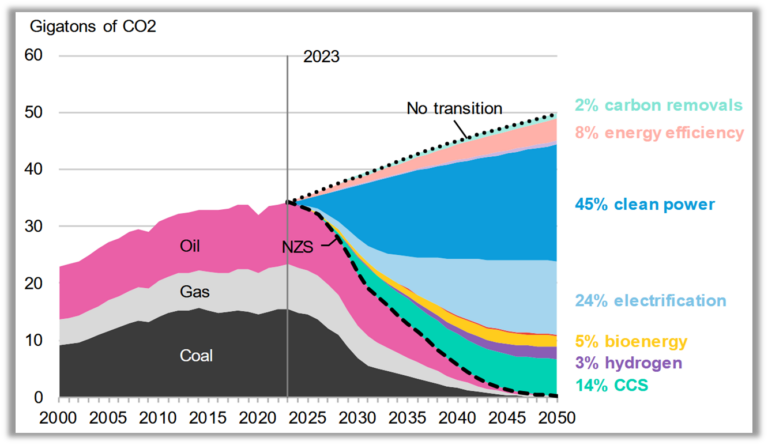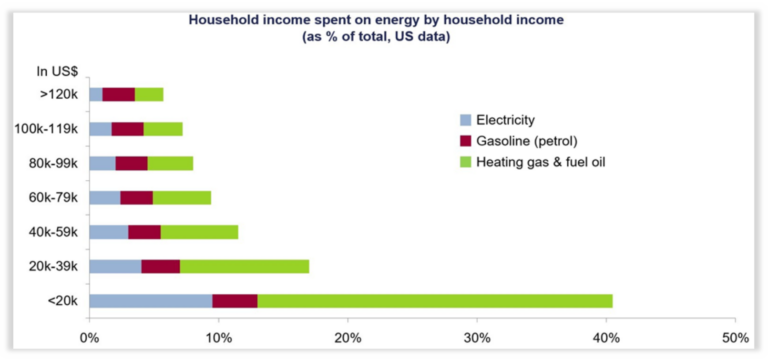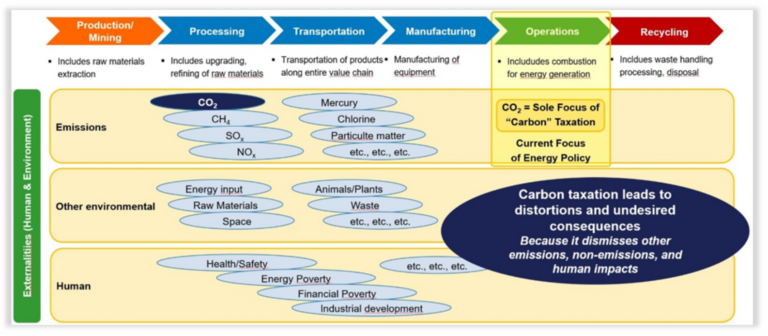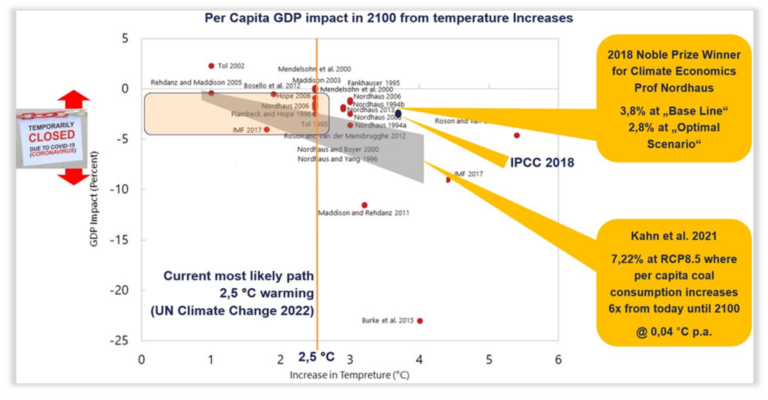UN Chief in May 2024: “Ban fossil fuel advertising”
Growing up in Eastern Germany, I was taught that money is the root of all evil particularly if it is made in the Western free-market system. Having now spent over 20 years in commodities and global energy markets, I concluded otherwise and find that distortions of artificial incentives, rather than those that arise freely, is the source of much misrepresentation.
As an energy economist I am confronted daily with questions about the “energy transition” away from conventional fuels. As we know, the discussion about the “energy transition” stems from concerns about climatic changes.
The source of climatic changes is a widely discussed issue, with numerous policies and measures proposed to mitigate its impact. One such measure is the current and future pricing of carbon dioxide (CO2) emissions. The logic followed is that if human CO2 emissions are reduced, future global temperatures will be measurably lower, extreme weather events will be reduced, and sea-levels will rise less or stop rising all together.
Although intended to reduce greenhouse gases, this approach has sparked considerable debate. In this blog post I discuss the controversial topic of CO2 pricing, examining its economic and environmental ramifications.
Let me start with this: I agree that (1) Earth’s climate is changing, (2) the world has been warming since the Industrial Revolution in the 1800s, coinciding with the end of the Little Ice Age, (3) Humans have contributed to this warming, and – also – (4) anthropogenic or human CO2 emissions have contributed. Needless to say, I support all measures that reduce the environmental impact of our energy systems including harmful emissions.
However, this article is not about the causes of climatic changes, nor is it about the negative or positive effects of a warming planet and higher atmospheric CO2 concentrations. It is also not about the scientifically undisputed fact that we don’t know how much warming CO2 causes (a list of recent academic research on CO2’s climate sensitivity can be found at the end of this blog).
Nor do I unpack the undisputed and IPCC confirmed fact that each additional ton of CO2 in the atmosphere has less warming effect than the previous ton as the climate sensitivity of CO2 is a logarithmic function irrespective of us not knowing what that climate sensitivity is. I also don’t disucss the NASA satellite confirmed greening of the world over the past decades partially driven by higher atmopheric CO2 concentrations (see sources inc Chen et al. 2024).
Instead, this blog post is about the environmental and economic “sense”, or lack thereof, of pricing CO2 emissions as currently practiced in most OECD countries and increasingly seen in developing nations. It is about the “none-sense” of measuring practically all human activity with a “CO2 footprint”, often mistakenly called “carbon footprint”, and having nearly every organization set claims for current or future “Net-Zero” (Figure 1).
Before you click away and call me bananas, give me 5 minutes of your time… I promise that I do care about the future of our children and of the planet we inhabit. I am also aware that fossil fuels cannot nor should forever continue to power ~80% of our world, as they currently do.
Figure 1: CO2 emissions reductions from fuel combustion by measure, Net Zero Scenario versus no transition scenario. Source: Bloomberg NEF, New Energy Outlook, May 2024,
CO2 pricing aims to internalize the external costs of CO2 emissions, thereby encouraging businesses and individuals to reduce their “carbon footprint”.
The concept is straightforward: by assigning a cost to CO2 emissions, it becomes financially advantageous to emit less CO2. However, this simplistic view overlooks significant complexities and unintended consequences.
Our entire existence is based on drawing from nature (“renewable” or not), so the “Net-Zero” discussion ignores a fundamental requirement for our survival. I agree that it should be our aim to reduce the environmental footprint as much as possible but only if our lives, health, and wealth don’t deteriorate as a result.
Now, I am sure, some readers and many “activists” may disagree, which I respect but, at a global level, find unrealistic. However, I would assume that most agree that no-one’s life ought to be harmed or shortened for the sake of reducing the environmental impact made. Otherwise, there is little room for a conversation.
BloombergNEFs “New Energy Outlook” from May 2024 should possibly be called “CO2 Outlook”, as there is little to be found about energy and its economics but rather all about CO2 emissions and the so called “Net-Zero” (Figure 1), which is in line with media, government, and educational focus on primarily carbon dioxide emissions.
2. Economic and Environmental Impacts
One of the primary criticisms of CO2 pricing is that it addresses only one environmental externality while ignoring others. This narrow focus can lead to economic distortions, as it fails to account for the full spectrum of environmental and social impacts. For instance, while CO2 pricing might reduce emissions, it can also drive-up energy costs, disproportionately affecting lower-income populations and hindering economic development in lesser developed countries.
It is by now undisputed amongst energy economists that, large-scale “Net-Zero” intermittent and unpredictable wind and solar power generation increases the total or “full” cost of electricity, primarily because of their low energy density, intermittency, inherent net energy and raw material inefficiency, mounting integration costs for power grids, and the need for a drastic overbuild installation system plus an overbuild backup/storage system because of their intermittency.
- In my short 13 min presentation, held at a large Institutional Investor conference in Frankfurt earlier this year, I explain why wind and solar increases the full cost of electricity. (more details can be found in our peer-reviewed paper Schernikau et al. 2022.)
- McKinsey and Wood Mackenzie estimates that the “energy transition” will reduce global GDP by 7-10% in 2050, in the western world this may translate to 15-20% of GDP (see Vaclav Smil 2022, Idel 2022, and with all sources my short YouTube summary
CO2 pricing can also result in environmental trade-offs. For example, the shift towards “renewable” energy sources like wind and solar, incentivized by CO2 pricing, has its own set of environmental impacts, including land use, resource extraction, energy footprint, and energy storage challenges. These “renewable” sources often require, due to their intermittent nature, backup systems powered by fossil fuels, undermining the intended emission reduction. When BloombergNEF (Figure 1) displays how clean power and electrification will directly reduce CO2 emissions to zero, then they are clearly mistaken. My recent blog post on primary energy discusses this topic.
My native country Germany provides a notable example of the complexities involved in transitioning to “renewable” energy. The country has invested heavily in wind and solar power, leading to the highest electricity costs among larger nations. Germany’s installed wind and solar capacity is now twice the total peak power demand. This variable “renewable” wind and solar power capacity now produces about a third of the country’s electricity and contributes about 6% to Germany’s primary energy supply (Figure 2).
In 2022, Germany depended to ~80% on oil, coal, and gas for its total energy supply, which was roughly the same average as the rest of the world. Thanks to France’s nuclear plants, Europe did manage to reduce this to ~70%.
Figure 2: German installed power capacity, power generation, primary energy 2002 until 2022. Sources: Schernikau based on Fraunhofer, Agora, AG Energiebilanzen. See also www.unpopular-truth.com/graphs.
3. Global Economic Implications
Higher energy costs, obviously and undisputedly, hurt less affluent people and stifles the development of poorer nations (Figure 3). Thus, a move to more expensive wind and solar energy has “human externalities”. The less fortunate will be “starved of” energy as they wouldn’t be able to afford it, leading to literal reduction in life expectancy.
The years 2021/2022 where the first in modern history where the number of people without access to electricity did NOT decline but rather increased by a surprising 20 million. COVID lockdowns and high energy costs caused financial strain, impoverishing people and causing energy starvation for entire industries. Consider, that Africa today houses around 100 million MORE people without access to electricity than it did 20 years ago. (sources: IEA, Financial Times, Bloomberg, Schernikau et al 2022).
This transition has already had profound economic implications. The emphasis on wind and solar, driven by CO2 pricing, has inadvertently increased energy poverty, highlighting the cost to humanity of such policies and disregarding the value of low cost energy from oil, coal, and gas. According to the March 2024 report by the German government auditor “Bundesrechnungshof”, energy poverty in German households increased from 15% in 2021 to 25% in 2022/23.
To fully understand the environmental impact of energy systems, a comprehensive life cycle analysis is essential. This involves emissions (various chemicals, particles, and greenhouse gases), raw material input, energy input (that is the energy needed to produce usable energy for consumption), land or space requirements,impact on local climate, animal and plant life, as well as lifetime operational maintenance, decommissioning, waste disposal, and so much more. In addition, there are human health, safety, and financial considerations we should not lose sight of.
Most importantly, the life cycle analyses should include the entire system required to produce usable energy ready for final consumption (i.e. electricity and gasoline on demand). The vast majority of today’s life cycle analyses set narrow boundaries and fail to include the entire system.
CO2 pricing typically focuses only on emissions during operation, neglecting significant environmental and economic costs incurred during other stages or by the entire system.
For instance, the production of solar panels involves substantial energy and raw material inputs. Today there is not one single solar panel that is produced without coal. Similarly, the manufacturing and transportation processes of wind turbines and electric vehicles are energy-intensive and environmentally impactful. These stages are rarely accounted for in CO2 pricing schemes, leading to a distorted view of their true environmental footprint. Also not accounted for are a) the required overbuild, b) short and long-duration energy storage, c) backup facilities, or d) larger network integration and transmission infrastructure.
Figure 3: Household income spent on energy by total household income; Source: Eschenbach 2017; Figure 38 in Book “The Unpopular Truth… about Electricity and the Future of Energy”
Figure 4 illustrates how virtually all CO2 pricing or taxation happens only at the stage of “operation” or combustion. How else could a “Net-Zero” label be assigned to a solar panel produced from coal and minerals extracted in Africa with diesel-run equipment, transported to China on a vessel powered by fuel-oil, and processed with heat and electricity from coal- or gas-fired power partially using forced labour? All this energy-intensive activity and not a single kilogram of CO2 is taxed (see my recent article on this subject here) The same applies to wind turbines, hydro power, biofuel, or electric vehicles.
For example, according to Fraunhofer, in 2022, Germany reached an average “CO2-Certificate” price of 80 EUR/t, which is more than 3x higher than in 2020 and 13x than in 2017. This price was solely charged for measured CO2 emissions from fossil fuel combustion increasing power prices accordingly. Needless to say, wind and solar were not taxed, nor were electric vehicles, running on coal- and gas- fired power. On the other hand, diesel and gasoline powered cars were taxed. CO2 emitting companies can off-set their CO2 emissions in elaborate off-set schemes that often have questionable, if any, environmental benefits (see also the Guardian on “worthless rainforest offsets”)
It turns out, CO2 tax is basically just a means to redistribute wealth, with the collecting agency (government) deciding where the funds go. Yes, a CO2 tax does incentivize industry to reduce CO2 emissions at their taxed operations only, but this comes at a cost to economies, the environment, and often people (i.e., AP News on Maynmar, ABC News on Congo, Hickmann et al 2021 on climate anxiety).
I believe you are starting to see my point. Any economist will confirm that pricing one externality but not others leads to economic distortions and, many would say worse, environmental impacts.
4. Alternative Approaches
Distortion, in this case, is just another word for unintended consequence to the environment, our economies, and the people. Pricing CO2 only during combustion but failing to price methane, raw material and recycling, inefficiency, or embodied energy, or energy shortages, or land requirement, or greening from CO2… will cause undesirable outcomes. The world will be worse off economically and environmentally.
Protest if you must, but let me offer a simple example. The leaders of the Western world seem to have united around abandoning coal immediately, because it is the highest CO2 emitter during combustion (UN 2019). Instead, demanding reliable and affordable energy, Bangladesh, Pakistan, Germany, and so many more nations have embraced liquified natural gas (LNG) as a “bridge” fuel to replace coal. This “switch” is taking place despite questions about LNG’s impact on the environment, including the “climate”. This policy, supported by almost all large consultancies, indirectly caused blackouts affecting over 150 million people in Bangladesh in October 2022 (Reuters and Bloomberg).
For full disclosure, I support all reliable and efficient means of energy supply, including gas. I own shares in gas companies, and I have worked a significant portion of my time in the commodity and coal industries. However, trust me, this article is not motivated by any financial gain.
Prof. Claudia Kemfert (green “energy transition” protagonist, energy economist, “climate scientist”, energy advisor to the German government) wrote an academic paper in 2022 pointing out that fugitive methane from gas production has a higher “climate” impact than CO2. This was confirmed by a more recent analysis by Howarth 2023.
Our own earlier academic paper from 2022 available in German and English at Elsevier’s SSRN goes one step further. Using only IPCC and IEA data, it concludes that on average LNG is “worse for the climate” than coal. (also on YouTube). At the IPCC’s 20-year Global Warming Potential GWP20, it was established that anthropogenic airborne CO2 accounts for “only” 35% of all anthropogenic greenhouse gases. Now, I do have concerns about the validity of those GWP and climate sensitivity assumptions of the IPCC, but we used them in anyway, maybe we shouldn’t have (Kleinberg 2020, McKitrick 2022).
So, the world is embarking on an expensive venture to replace as much coal as possible with more expensive liquified natural gas LNG. On top of that, wind and solar are given preference. For example, the IEA recently confirmed that 2024 sparks the first year where investments in solar outstrip the combined investments in all other power generation technologies. As a result, energy costs go up, dependencies increase, lights go off, and, as per the UN’s IPCC, the “climate gets worse.”
This is exactly the result of CO2 taxation which is just one example of an environmental and economic distortion. By focusing only on CO2, Bangladesh is driven to overreliance on LNG and suffers blackouts as a result. If methane (CH4) from LNG’s production and other sources were taxed, we would see some changes in the world.
Now imagine what would happen if we would truly take into account all environmental and human impacts, both negative and positive, along the entire value chain of energy production, transportation, processing, generation, consumption, and disposal… we would all be surprised! You would look at fossil fuels and certainly nuclear through different eyes.
Instead we should simply incentivize resource and energy efficiency which will truly make a positive difference!
Figure 4: Environmental Impact of Energy Systems; Source: Schernikau, adapted from Figure 39 in Book “The Unpopular Truth… about Electricity and the Future of Energy“
5. Conclusion
No matter what your view on climate change is, pricing CO2 is harmful… why?
One-sentence answer: … because pricing one externality but not others lead to economic and environmental distortions… causing human suffering.
That is why, even considering the entire value chain, I do not support any CO2 pricing.. That is why I fight for environmental and economic justice so we can, by avoiding energy starvation and resulting poverty, make a truly positive difference not only for ourselves but also for future generations to come.. We need INvestment in, not DIvestment from 80% of our energy supply to rationalize our energy systems and to allow people and the planet to flourish.
I strongly support increasing adaptation efforts, which have already been successful in drastically reducing the death rate and GDP adjusted financial damage from natural disasters during the past 100 year (OurWorldInData, Pielke 2022, Economist).
The debate about CO2 pricing highlights the complexities of addressing climatic changes. By rethinking our approach to environmental policy, we can better balance the needs of economic development, social equity, and environmental protection. This requires a nuanced understanding of the interconnected nature of these issues and a commitment to addressing them in a holistic and integrated manner.
6. Supplementary commentary and notes
Author’ note on damages from climatic changes (Figure D):
Summarized in “How human disruptions impact GDP“ here on YouTube
- McKinsey estimates annual costs of 9.2 Trillion USD until 2050 to reach “Net Zero” CO2. This is roughly 8% of global annual GDP, every single year until 2050. It must be noted that McKinsey did not model the cost of methane “NetZero” nor any cost to the environment, the population, or industries from rising energy costs and energy shortages (Bloomberg)… therefore, in my humble view, the costs are drastically underestimated. Vaclav Smil estimated up to 20% of GDP cost for western nations.
- Future cost of climatic changes were also calculated by Prof. Nordhaus (2018 Noble Price Winner in Climate Economics for exactly this calculation) to be 3.8% of GDP in the year 2100 in his base case – or no climate policy scenario – at 4 °C warming from pre-industrial times until 2100. In October 2023 the UN and John Kerry (US Climate Envoy) confirmed reduced expected warming of about 2,5 °C from pre-industrial times until 2100.
- The most recent peer-reviewed study on the economic benefits and costs was written by Dr Tol and published in November 2023 coming the same conclusion that it doesn’t make economic sense as the projected costs of climate change are less than the underestimated costs of the “energy transition”. He concludes “The Paris targets to not pass the cost-benefit test”.
- It must be noted that (1) the GDP in 2100 is expected to be ~4.5x higher than today… so after 3.8% reduction it would result in “only” ~4.3x higher, (2) Nordhaus used the unrealistic RCP8.5 emissions scenario and assumes no adaptation, (3) UN Climate Change informed in October 2022, the world is “on track for around 2.5 °C of warming by the end of the century” not the 4 °C assumed by Nordhaus, and (4) the IPCC 2018, p256 mentioned a 2.6% GDP loss in 2100 from 3.7 °C warming.
- Interestingly, Prof. Nordhaus concluded in his Noble Price winning paper “… there is virtually no chance that the rise in temperature will be less than the target 2°C even with immediate, universal, and ambitious climate change policies.”
For more research and analyses see www.unpopular-truth.com or https://www.linkedin.com/lars-schernikau
Figure 5: Peer-reviewed literature confirms «un-catastrophic» GDP Impact of projected temperature increases… we should still adapt and further reduce any impact; Source: Schernikau adapted from Kahn et al 2021 (their best estimates shaded in grey)
7. References
- ABC News 2022: The rush for cobalt in the Congo reveals the human cost of the world’s green energy future
- AP News 2022: ‘The Sacrifice Zone’: Myanmar bears cost of green energy
- Bloomberg 2024: Germany’s Days as an Industrial Superpower Are Coming to an End
- Bundesrechnungshof 2024: Energiewende nicht auf Kurs: Nachsteuern dringend erforderlich
- Financial Times 2022: Will the energy crisis crush European industry?
- Fraunhofer 2023: on various energy economic statistics in Germany
- Guardian 2023: more than 90% of rainforest carbon offsets by biggest provider are worthless, analysis shows
- Hickmann et al 2021: Climate anxiety in children and young people and their beliefs about government responses to climate change: a global survey
- Howarth 2023: The Greenhouse Gas Footprint of Liquefied Natural Gas (LNG) Exported from the United States
- Idel 2022: Levelized Full System Costs of Electricity
- IEA 2022: For the first time in decades the number of people without access to electricity is set to rise in 2022
- Kemfert et al 2022: The expansion of natural gas infrastructure puts energy transitions at risk
- Schernikau et al 2022: Full Cost of Electricity ‘FCOE’ and Energy Returns ‘eROI’
- UN 2019: Is the world ready to end the coal era and embrace clean energy?
- Vaclav Smil 2022: Decarbonization Is Our Costliest Challenge: It has no clear beginning or end, and it affects every aspect of life
- UN 2024: BBC on Climate Change: Ban Fossil Fuel Advertising Says UN Chief
List of selected more recent scientific research about uncertainties in CO2’s climate sensitivity and greening of the world:
- Harde et al. 2017: Radiation Transfer Calculations and Assessment of Global Warming by CO2
- Wijngaarden and Happer 2020: Dependence of Earth’s Thermal Radiation on Five Most Abundant Greenhouse Gases
- Chen et al. 2024: The global greening continues despite increased drought stress since 2000
- Coe et al. 2021: The Impact of CO2, H2O and Other “Greenhouse Gases” on Equilibrium Earth Temperatures
- Duebal and Vahrenholdt 2021: Radiative Energy Flux Variation from 2001–2020
- Kleinberg 2020: The Global Warming Potential Misrepresents the Physics of Global Warming Thereby Misleading Policy Makers
- Lindzen Christy 2024: Reassessing the Climate Change Narrative
- McKitrick 2022: On climate senstivity
- Nasa 2017: CO2 is making Earth greener—for now
- Lewis 2022: Objectively combining climate sensitivity evidence
- Scafetta 2023: CMIP6 GCM Validation Based on ECS and TCR Ranking for 21st Century Temperature Projections and Risk Assessment
- Soon et al 2023: The Detection and Attribution of Northern Hemisphere Land Surface Warming (1850–2018) in Terms of Human and Natural Factors: Challenges of Inadequate Data






